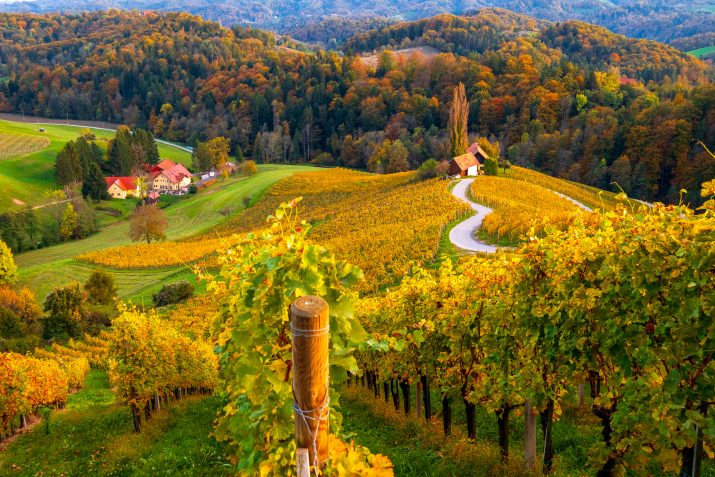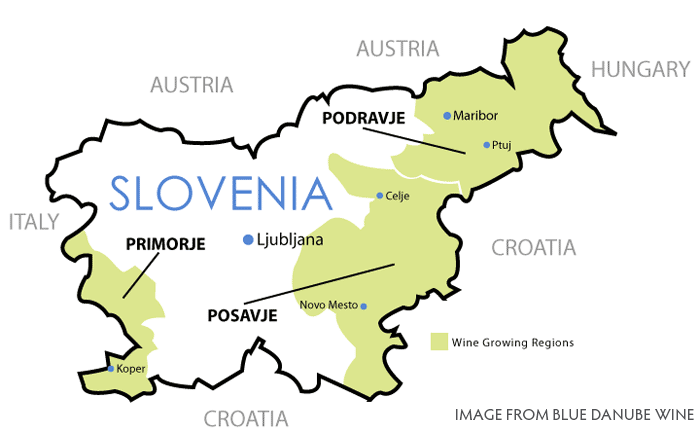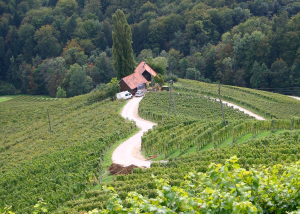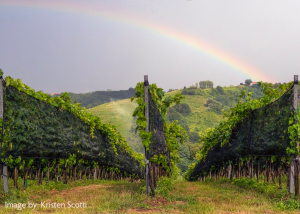3 Key Wine Regions of Slovenia

Slovenia, although a small country, it has a rich winemaking tradition. The roots of Slovenian winemaking go back to the Celts and Illyrians in the 5th century B.C.E. The diversity of grapes is influenced by its climate, due to its position near the Adriatic Sea on its western flank and the Julian Alps to its north.
Discover some of Slovenia’s winemaking heritage on our 8-day Slovenia Discovery Small Group Journey. You’ll see the beautiful vineyards, enjoy a wine tasting and visit the town of Maribor, the proud home to the Stara Trta, the world’s oldest producing vine.
An Overview of Slovenia’s Wine Regions
Slovenia has three primary winemaking regions, Primorje in the west, Prodravje in the east and Posavje in the southeast.

The wine regions of Slovenia
1. Primorje
Primorje/the Primorska wine region is in the west of Slovenia. It borders Italy and the Adriatic Sea. Meaning ‘near the sea’, Primorje is the most developed wine region in the country. And is responsible for the most wine production. The region is heavily influenced by its Italian neighbors in terms of its wine, language, and culture.
There are four sub-regions making up the Primorska region. Goriška Brda, the Vipava Valley, the Karst region, and Slovenian Istria. Goriška Brda is a hilly area bordering Italy that is referred to as “Slovenia’s Tuscany”. The Vipava Valley’s vineyards are found along both sides of the river Vipava.
The Karst region is known for its unique red soil and cave formations in its porous rock. It is the smallest of the Primorska wine sub-regions. Slovenian Istria lies near the Croatian coastline and its hilly, forested lands enjoy a Mediterranean climate of hot summers and mild winters.
2. Podravje
Podravje/the Podravska wine region is in the northeastern and eastern portions of the country. Bordered by Austria on the north and Hungary and Croatia on the east. Podravje, referring to the valley of the Drava River, is the largest wine region in area. And second largest to the Primorska region in terms of total wine production.
Prodravje is comprised of two primary sub-regions, Prekmurje in the northeast named after the Mura River, and Štajerska, the Slovenian extension of Austria’s Styria, making up the rest of the region. Prekmurje’s wine making is influenced by Hungary. While Štajerska leans on Germanic influences from its Austrian neighbour.

A heart-shaped road in the vineyards of Špičnik
3. Posavje
Posavje/the Posavska wine region is the smallest of the country’s wine regions, located in the south-central area of Slovenia. Named after the river Sava, Posavje borders Croatia to its south.
The Posavje region is comprised of three wine-growing areas: Bela Krajina, Dolenjska, and Bizeljsko-Sremić. One of the unique features of the region are the small stone cottages found in vineyards. These are often used as wine cellars and can be rented by visitors to spend the night.
Types of Slovenian Wine by Region
In general, white wine is more popular in Slovenia than red wine. It represents almost 75% of total Slovenian wine production, with red wines about one quarter.
1. Primorska Wines
Although the Primorska region is best known for its white wines, it also produces most of the red wines coming from Slovenia. Primorska has the largest number of indigenous white grape varieties in the country. Each region has its specialty wine; Goriška Brda is well known for its indigenous white Rebula, while the Vipava Valley is home to the native-grown white grape varieties of Pinela and Zelen.
The red soil or terra rossa of the Karst is famous for its rich, ruby red, high acidity Teran wine. Slovenian Istria has its native red grape called Refosco, along with whites such as Malvasia and Rebula.
2. Podravska Wines
This region, which is responsible for about half the country’s wine output, also creates mainly white wines. It consists of 95% of all wine production. Much of the white wine is like that produced in the neighbouring countries of Austria and Hungary. Here you’ll find Riesling and Traminer wines reflecting the Germanic influence. Chardonnay, Sauvignon and Pinot Blanc, and Šipon (Furmint) highlight the Hungarian wine influence, most notably produced in the hilltop village of Jeruzalem.

Jeruzalem, Slovenia
Among the red grape varieties here are Pinot Noir, Blue Franconia, and the so-called Black Velvet, which is the type of grape grown in Maribor on the world’s oldest vine. The Prodravska wines also include quality sparkling wines and dessert wines, as well as ice wine.
3. Posavska Wines
Posavje is Slovenia’s smallest wine producing area and is best known for the Cviček made in the Dolenjska area. This blend of white and red wine is the region’s specialty. It has a low alcohol content, and has a light, slightly sour taste. Posavje is generally known for producing table wines for domestic consumption.
Wine Harvest Season
Slovenia’s wine harvest typically runs from late August to early October. Harvesting begins first in coastal Primorska. The grapes take a little longer to ripen in the he southern and eastern wine making sections of the country (Posavje and Podravje).
Harvest season is a time of festivals celebrating the new wine. The Vipava Valley celebrates the second weekend in September with wine tastings, and the crowning of a Vipava Wine Queen. Maribor’s Old Vine Festival honours its record-setting oldest producing vine from early October to mid-November. And St. Martin’s Day on November 11th gives thanks to the saint who supposedly turned water into wine.

